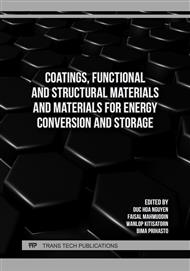[1]
Barsan, N., D. Koziej, and U. Weimar, Metal oxide-based gas sensor research: How to? Sensors and Actuators B: Chemical, 2007. 121(1): pp.18-35.
DOI: 10.1016/j.snb.2006.09.047
Google Scholar
[2]
Dey, A., Semiconductor metal oxide gas sensors: A review. Materials Science and Engineering: B, 2018. 229: pp.206-217.
DOI: 10.1016/j.mseb.2017.12.036
Google Scholar
[3]
Raub, J.A., et al., Carbon monoxide poisoning — a public health perspective. Toxicology, 2000. 145(1): pp.1-14.
Google Scholar
[4]
Wang, X., et al., Design of ultrahigh-response gas sensor based on Pd-WO3/WS2 ternary nanocomposites for ultrafast hydrogen detection. Sensors and Actuators B: Chemical, 2024. 401: p.134991.
DOI: 10.1016/j.snb.2023.134991
Google Scholar
[5]
Verma, A.K., et al., Enhanced hydrogen gas sensing performance with Ag-doped WO3 thin film. International Journal of Hydrogen Energy, 2024.
Google Scholar
[6]
Pai, S.H.S., et al., Effect of calcination temperature on NiO for hydrogen gas sensor performance. International Journal of Hydrogen Energy, 2024. 50: pp.928-941.
DOI: 10.1016/j.ijhydene.2023.07.345
Google Scholar
[7]
Yamaura, H., et al., Indium oxide-based gas sensor for selective detection of CO. Sensors and Actuators B: Chemical, 1996. 36(1-3): pp.325-332.
DOI: 10.1016/s0925-4005(97)80090-1
Google Scholar
[8]
Kim, H.S., et al., Oxidative Carbonylation of Aromatic Amines by Selenium Compounds. Journal of Catalysis, 1999. 184(2): pp.526-534.
DOI: 10.1006/jcat.1999.2458
Google Scholar
[9]
Hung, N.M., et al., CuO nanoparticles prepared by alcohol-assisted hydrothermal synthesis for gas-sensing application: effect of pH value. Communications in Physics, 2023. 33(4).
DOI: 10.15625/0868-3166/18283
Google Scholar
[10]
Hung, N.M., et al., Rb2CO3-decorated In2O3 nanoparticles for the room-temperature detection of sub-ppm level NO2. Sensors and Actuators B: Chemical, 2020. 313: p.128001.
DOI: 10.1016/j.snb.2020.128001
Google Scholar
[11]
Hung, N.M., et al., Carbon nanotube-metal oxide nanocomposite gas sensing mechanism assessed via NO2 adsorption on n-WO3/p-MWCNT nanocomposites. Ceramics International, 2020. 46(18): pp.29233-29243.
DOI: 10.1016/j.ceramint.2020.08.097
Google Scholar
[12]
Murthy, P.S., et al. Antibiofilm activity of nano sized CuO. in International Conference on Nanoscience, Engineering and Technology (ICONSET 2011). 2011.
DOI: 10.1109/iconset.2011.6168037
Google Scholar
[13]
Shou, H., Rb-Promoted Molybdenum Carbide Nano-Catalysts for Higher Alcohol Synthesis from Syngas. 2013, University of Virginia.
DOI: 10.18130/v34z3b
Google Scholar



